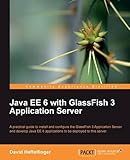Java EE 6 with GlassFish 3 application server / David Heffelfinger.
Material type: TextSeries: Community experience distilledPublication details: Birmingham, U.K. : Packt Pub., ©2010.Description: 1 online resource (vii, 469 pages) : illustrationsContent type:
TextSeries: Community experience distilledPublication details: Birmingham, U.K. : Packt Pub., ©2010.Description: 1 online resource (vii, 469 pages) : illustrationsContent type: - text
- computer
- online resource
- 9781849510370
- 1849510377
- 1849510369
- 9781849510363
- 004.654 22
- QA76.73.J38 H44 2010eb
| Item type | Home library | Collection | Call number | Materials specified | Status | Date due | Barcode | |
|---|---|---|---|---|---|---|---|---|
 Electronic-Books
Electronic-Books
|
OPJGU Sonepat- Campus | E-Books EBSCO | Available |
Print version record.
Annotation GlassFish is a free, open source, production ready application server. It is the environment's reference implementation and the first Enterprise Java server to implement Java EE6. Although GlassFish server delivers a flexible, lightweight and extensible Java EE 6 platform, it can be challenging to get beyond the basics and develop Java applications deployed to GlassFish 3 application server.<br /><br />This book takes an in-depth look at all of the major new features in Glassfish 3 and how it differs from previous Glassfish versions. This book explains GlassFish installation and configuration, and then moves on to Java EE 6 application development, covering all major Java EE 6 APIs. It is a handy guide for the advanced Java programmers as well as Java EE 6 beginners.<br /><br />This book begins with the installation of Glassfish 3 and deploying Java applications. It also explains how to develop, configure, package and deploy servlets. We will also learn the processing of HTML Forms. As we move on, we will develop Java Server Pages and get to know implicit JSP objects. We will get to know all the JSTL (JSP Standard Tag Library) tag libraries. This book gives us a better understanding on how to manage data from a database through Java Database Connectivity (JDBC) API and the Java Persistence API (JPA). We will also learn more about the newly introduced features of JPA 2.0 and develop JSF 2.0 applications learn how to customize them. We then set up Glassfish for Java Messaging (JMS) API and understand the working of message queues and message topics. Later, we use the Context and Dependency Injection (CDI) API to integrate application layers and study the SOAP based web service development using the JAX-WS specification. Finally, we learn more about the Restful web service development using the JAX-RS specification.<br /><br />The book covers the various Java EE 6 conventions and annotations that can simplify enterprise Java application development. The latest versions of the Servlet, JSF, JPA, EJB and JAX-WS specifications are covered, as well as new additions to the specification such as JAX-RS and CDI.<br /><br />This book is a Developer_s Guide, covering the ins and outs of developing Java EE 6 applications deployed to the standards-compliant, high performance GlassFish 3 application server.
Java EE 6 with GlassFish 3 Application Server; Java EE 6 with GlassFish 3 Application Server; Credits; About the Author; About the Reviewers; Preface; What this book covers; What you need for this book; Who this book is for; Conventions; Reader feedback; Customer support; Errata; Piracy; Questions; 1. Getting Started with GlassFish; Overview of Java EE and GlassFish; What's new in Java EE 6; JavaServer Faces (JSF) 2.0; Enterprise JavaBeans (EJB) 3.1; Java Persistence API (JPA) 2.0; Contexts and Dependency Injection for Java (Web Beans 1.0); Java Servlet API 3.0.
Java API for RESTful web services (JAX-RS) 1.1Java API for XML-based web services (JAX-WS) 2.2; Java Architecture for XML Binding (JAXB) 2.2; What's new in GlassFish v3; GlassFish advantages; Obtaining GlassFish; Installing GlassFish; GlassFish dependencies; Performing the installation; Verifying the installation; Deploying our first Java EE application; Deploying an application through the Web Console; Undeploying an application through the Web Console; Deploying an application through the command line; The autodeploy directory; The asadmin command line utility; GlassFish domains.
Creating domainsDeleting domains; Stopping a domain; Setting up database connectivity; Setting up connection pools; Setting up data sources; Final notes; Summary; 2. Servlet Development and Deployment; What is a servlet?; Writing our first servlet; Compiling the servlet; Configuring the servlet; Packaging the web application; Deploying the web application; Testing the web application; Processing HTML forms; Request forwarding and response redirection; Request forwarding; Response redirection; Persisting application data across requests; New features introduced in Servlet 3.0.
Optional web.xml deployment descriptor@WebServlet annotation; Passing initialization parameters to a servlet via annotations; @WebFilter annotation; @WebListener annotation; Pluggability; Configuring web applications programmatically; Asynchronous processing; Summary; 3. JavaServer Pages; Introduction to JavaServer Pages; Developing our first JSP; JSP implicit objects; JSPs and JavaBeans; Reusing JSP content; JSP custom tags; Extending SimpleTagSupport; Using tag files to create custom JSP tags; Unified Expression Language; JSP XML syntax; Summary; 4. JSP Standard Tag Library.
Core JSTL tag libraryFormatting JSTL tag library; SQL JSTL tag library; XML JSTL tag library; JSTL functions; Summary; 5. Database Connectivity; The CustomerDB database; JDBC; Retrieving data from a database; Modifying database data; The Java Persistence API; Entity relationships; One-to-one relationships; One-to-many relationships; Many-to-many relationships; Composite primary keys; Java Persistence Query Language; New features introduced in JPA 2.0; Criteria API; Bean Validation support; Summary; 6. JavaServer Faces; Introduction to JSF 2.0; Facelets; Optional faces-config.xml.
eBooks on EBSCOhost EBSCO eBook Subscription Academic Collection - Worldwide
There are no comments on this title.

